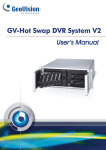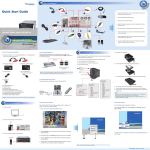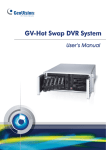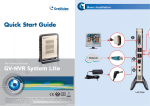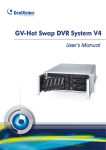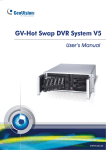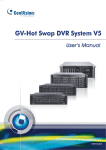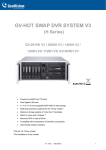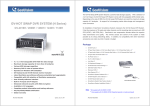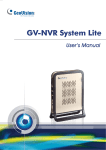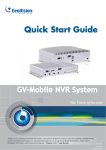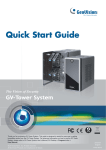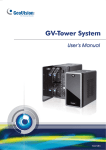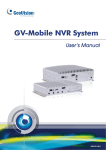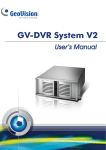Download Quick Start Guide GV-HOT SWAP DVR SYSTEM V4
Transcript
1 Basic Installation Check the Accessories Supplied D-Type Video Cable x 2 * D-Type Video Cable x 4 for 32-channel models Quick Start Guide * ONLY supplied with 20-bay models of GV-1480H V4, GV-1240H V4 and GV-1120H V4 D-Type Audio Cable x 2 * D-Type Audio Cable x 4 for 32-channel models * ONLY supplied with 20-bay models of GV-1480H V4, GV-1240H V4 and The Vision of Security GV-1120H V4 GV-HOT SWAP DVR SYSTEM V4 D-Type Audio and Video Cable x 2 * D-Type Audio and Video Cable x 4 for GV-2016H V4 ** * ONLY supplied with 2-bay and 20-bay models of GV-2008H V4 ** ONLY supplied with 20-bay models of GV-2016H V4 RoHS Thank you for purchasing GV-Hot Swap DVR System V4. This guide is designed to assist the new user in getting immediate results from the GV-Hot Swap DVR System V4. For advanced information on how to use the GV-Hot Swap DVR System V4, please refer to GV-Hot Swap DVR System V4 User's Manual and Surveillance System User's Manual on DVD. © 2009 June GeoVision Inc. All rights reserved. DVRHV4-QG-A Connecting GV-Keyboard AC Power Cord x 1 RJ-11 to DB9 Cable x 1 Using the USB cable supplied with the GV-Keyboard, plug one end into the GV-Keyboard and the other end into the assigned USB port (COM6) on the back of the GV-Hot Swap DVR V4. USB Cable GV-Keyboard Package x 1 COM6 COM8 COM7 COM9 * Not available for GV-NVRH V4 and all 2-bay models GV-IR Remote Control x 1 GV-Keyboard RJ-11 to USB Cable x 1 GV-Hot Swap DVR V4 Rear View Note: If you like to plug the Keyboard into other USB ports of the GV-Hot Swap DVR V4, refer to 3.13.1 GV-Keyboard in GV-Hot Swap DVR System V4 User's Manual. * Not available for GV-NVRH V4 and all 2-bay models Connecting GV-IR Remote Control GV-IR Remote Control Receiver x 1 Self-Stick Rubber Pad x 4 Recovery DVD x 1 The GV-IR Remote Control provides easy control of the GV-Hot Swap DVR V4. Its receiver is differently installed depending on the models. Except that it is built in all 20-bay models, the Receiver should be plugged into any USB ports of the GV-Hot * Not available for all 20-bay models Swap DVR V4. Nero CD Burning Software x 1 For details, see GV-IR Remote Control User’s Manual included in the package. Surveillance System Software DVD x 1 GV-IR Remote Control User’s Manual x 1 GV-Hot Swap DVR System V4 User’s Manual x 1 GV-Hot Swap DVR System V4 Quick Start Guide x 1 Surveillance System New Feature Guide x 1 Surveillance System Installation Guide x 1 GV-IR Remote Control GV-Hot Swap DVR V4 4 / 8-Bay Models of GV-1480H V4 / GV-1240H V4 / GV-1120H V4 (16 Channels) 7 8 1 6 2 4 3 5 Internet 4 / 8-Bay Models of GV-1480H V4 / GV-1240H V4 / GV-1120H V4 (32 Channels) Audio 1~8 Audio 9~16 1. Using the supplied power cord, connect one end to the AC Video 1~8 input and the other end to the power outlet. Video 17~24 2. Connect the keyboard to the PS/2 input. Video 25~32 3. Connect the mouse to the PS/2 input. Video 9~16 4. Using the VGA cables supplied by the monitor manufacturer, Audio 25~32 Audio 17~24 connect the VGA monitor. 5. For video lost beep, connect speakers to the Audio Line Out port. 6. Using the RJ-45 cable, connect one end to the Ethernet port and the other end to Network. 20-Bay Models of GV-1480H V4 / GV-1240H V4 / GV-1120H V4 (32 Channels) Video 17~24 Video 1~8 7. Using the BNC video cables, connect one end to the BNC connectors and the other end to video sources. Audio 1~8 8. Using the supplied D-type audio cables, connect one end to Audio 17~24 the audio ports and the other end to audio sources. Audio 25~32 Audio 9~16 Video 9~16 Video 25~32 2 Connecting to 2 Monitors Available models: GV-NVRH V4 GV-2008H V4 GV-1480H V4 / GV-1240H V4 / GV-1120H V4 (16 Channels) Install the Hard Drive The GV-Hot Swap DVR V4 uses SATA hard drives for video and audio data storage. Before recording, ensure to install your hard drives. Steps to install the hard drive vary from models to models. Be sure to identify your model and follow the right steps to install the hard drive. 2 / 4 / 8-Bay Models 1. Turn off the power of the drive bay. Make sure the Power LED is off. Primary Monitor 2. Turn the safety lock to the OPEN position. 3. Press the safety lock. The drawer handle pops up. 4. Pull out the drive drawer. LOCK 4 / 8-Bay Models of GV-1480H V4 / GV-1240H V4 / GV-1120H V4 (16 Channels) 2 Safety Lock 3 OPEN Monitor 2 Connecting to 3 Monitors 4 Available models: GV-2016H V4 GV-1480H V4 / GV-1240H V4 / GV-1120H V4 (32 Channels) Drive Drawer Drawer Handle 1 Front panel of SATA backplane installed in the 10-bay model RESET Primary Monitor Front panel of SATA backplane installed in the 8-bay model Front panel of SATA backplane installed in the 4-bay and 6-bay models HD1 RESET HD2 Power Button HD1 HD3 Monitor 2 Power Button and LED HD2 HDD Activity LED Power Button and LED HD4 HD3 Power LED Fan LED 4 / 8-Bay Models of GV-1480H V4 / GV-1240H V4 / GV-1120H V4 (32 Channels) Monitor 3 5. Remove the lid of the drawer. 6. Insert the hard drive in the drawer, and slide the lid back on. 20-Bay Models 1. Make sure the HDD Activity LED is off before you install the hard drive. 2. Slide the release latch to the right. The drawer handle pops up. Release Latch 3. Pull out the drive drawer. 4. Insert the hard drive in the drawer. Step 5 Step 6 7. Insert the hard drive in the drawer, and slide the lid back on. 8. Put the drawer back in the drive bay of the GV-Hot Swap DVR V4. 9. Push the drawer handle back, and turn the safety lock to the LOCK position. 10. Press the Power button. When the Power LED indicates green, the hard drive is ready for use. 5. Secure the hard drive with the 4 screws (included in the drawer), and make sure all screw heads flush with the surface. Note: . Ensure to format hard drives before they are usable. See 3.4 Formatting the Hard Drive in GV-Hot Swap DVR System V4 User's Manual. . To assign hot-swap drives as storage locations, see Adding the Hard Drive to Recording Path later in this guide. 6. Put the drawer back in the drive bay of the GV-Hot Swap DVR V4, and push the latch until it locks. The white LED on the drawer shines, and the hard drive is now ready to use. 3 2 Turn on the Power 1. Turn on the monitor. 3. Turn on the main power switch on the front panel. 4 / 8-Bay Models Power On On 2. Turn on the AC power switch on the rear panel. 4 / 8-Bay Models 20-Bay Models On Power On 20-Bay Models On Configuring an IP Address Exiting to Windows The purpose of configuring an IP address is to support the remote monitoring, control and configuration of the GV-Hot Swap DVR V4 over a network connection. The unit is protected by GV-Desktop that is limited to run the selected programs. If you need to exit to Windows desktop, follow these steps. 1. On the GV-Desktop, click the Programs button, and then select Control Panel. 1. On the GV-Desktop, click the Settings button, and type the valid ID and password. The default ID and password are “0000”. The Setting dialog box appears. 2. Type the ID and password. The default ID and password are “0000”. The Control Panel window appears. 2. Under Desktop Type, select Windows from the drop-down list, and click OK. 3. Click the Log Off button, and enter the valid ID and Password to display the Windows desktop. 3. Double-click Network Connections, right-click Local Area Connection, and then select Properties. 4. In the Local Area Connection Properties dialog box, select Internet Protocol (TCP/IP) and then click Properties. 5. Select Use the following IP address, type the IP infomation in the fields, and click OK to finish the setting. For details, refer to 3.8 Configuring an IP Address in GV-Hot Swap DVR V4 User’s Manual. 1 3 2 Continued on the reverse 4 3 Main Screen Returning to GV-Desktop Click the Windows Start button, point to Programs, click GVCombo, and click Key Lock Utility. Click to call up I/O Control Panel Click to call up PTZ Control Panel Status indicators for remote applications Date / Time / Storage Space Camera Name Logout / Exit / Minimize Select a camera for full screen mode Select screen divisions Adding Hot Swap Drive to Recording Path Before recording, you need to add the formatted hard drive to the recording path. Note: The default recording path for the hot-swap drives starts from F:\ Start/stop recording Set up recording schedules 1. On the GV-Desktop, click the Programs button, and select Hot Swap HDD Tool. 2. If a hard drive is already inserted, right-click it in the MediaMan Tools window, select Add for recording, and then select the storage group from the drop-down list. 3. If a hard drive is not inserted, follow these steps: Access system settings (1) Insert a hot-swap hard drive or plug a portable hard drive to the GV-Hot Swap DVR V4. This dialog box appears. Access ViewLog to play back video Start/stop screen rotation Access remote applications (2) Select Add to recording path, and select the storage group from the drop-down list. 4. Click OK to automatically configure the hard drive to the recording path. Choosing Recording Mode 5. In the MedianMan Tools window, if the hard drive is successfully added to store data, its Status field should display “Standby”. You can set each camera's recording mode individually for Motion Detection or Round-the-Clock. 1. Click on the main screen, point to General Setting, and select System Configure. Status field 2. Click the Camera Record Setting tab. 3. From the Camera Name drop-down list, select one camera. 4. In the Monitor Control section, select Rec Video, and use the drop-down list to select Motion Detect or Round-the-Clock. 6. To add another formatted hard drive for storage, repeat the above steps. Renaming the Camera 5. Click OK. For details on setting camera properties, refer to Adjusting Individual Camera, Chapter 1, User's Manual on Surveillance System Software DVD. You can give a new name for each camera. 2 1. Click on the main screen, point to General Setting, and select System Configure. 3 2. Click the Camera Record Setting tab. 3. In the Camera Name field, enter a new name for the camera. 4. Click OK. 4 5 4 Changing Recording Resolution Set Up a Recording Schedule The default recording resolution is 320 x 240. You can set each camera's recording resolution individually. You can program recording to turn on and off at a specific time each day. 1. Click 1. Click on the main screen, point to A/V Setting, and select Video Source. 2. Select the desired video resolution from the drop-down list, and click OK. on the main screen, and select Schedule Edit. 2. Select or enter the Start and End time of the schedule. 3. Select day(s). 4. Select Rec, and use the drop-down list to select Round-the-Clock or Motion Detect for recording mode. 5. Select camera(s). 6. Click Add Schedule. 7. Click OK. 3. Click on the main screen, point to General Setting, and select System Configure. For details, refer to Recording Schedule, Chapter 1, User's Manual on Surveillance System Software DVD. 4. Click the Camera Record Setting tab, and use the Camera Name drop-down list to select one camera. 4 5. Click the arrow button next to Recording Quality to select the desired resolution. 6. Repeat steps 4 and 5 to set up each camera. 7. Click OK. 2 4 3 5 6 5 7 7 6 5 Play Back Video Playback Controls You can play back video recorded during a particular date and time. 1. Click on the main screen, and select Video/Audio Log. Playback Scroll Audio on/off 2. Select the camera you wish to view. 3. Select a date folder from the date tree. 4. Select a time from the Video Events list. 5. Click to begin playback. For details, refer to Playing Back on ViewLog, Chapter 4, User's Manual on Surveillance System Software DVD. Rewind to Beginning 2 Rewind Frame-by-Frame Reverse Play Stop Forward to Zoom in/ End out A to B Playback Frame-by-Frame Forward Speed up/ down Frame-by-Frame/ Real Time Playback 3 4 Using the Zoom . Zoom in: Click the Zoom-in button, and then click on the area you want to magnify. Each click will increase the zoom level. . Zoom out: 5 Click the Zoom-out button, and then click on the image to zoom out. Each click will decrease the zoom level. 7 6 Back Up Video Files You can back up video files of the desired time to CD / DVD. 1. Insert the CD / DVD media into the drive. 2. Click on the main screen, and select Video/Audio Log. 3. Click on the functional panel. 4. Select CD Using OS-Burning to burn files with the inbuilt software of Windows XP. 5. Click Add time frame. 6. Enter the Start Time and End Time for backup. 7. Select the desired camera(s) for backup. The number of video and audio files of each camera is indicated respectively, e.g. “Camera 3 39+0” means the camera 3 has 39 video files and 0 audio file. 8. Select the types of events for backup, e.g. video, audio or both together. 4 5 9. Click OK to add the time frame. You can repeat steps 5-8 to create up to 10 time frames. 10. Click OK to start burning. For details, refer to Backing Up Video Files Using ViewLog, Chapter 5, User's Manual on Surveillance System Software DVD. 10 Playing Backup Files Open the backup folder, run EZViewLog500.exe, and then follow the instructions in the Play Back Video section. 6 7 8 9 8 6 Recovery DVD If preinstalled files are damaged, use the supplied Recovery DVD to restore them. To restore the operating system and all preinstalled software, follow these steps: 6. When the recovery is complete, the message “The recovery process is finished. Please remove DVD and press “OK” to reboot” will appear. Manually remove the DVD and then click OK. Note: After recovery, you need to re-install all settings and passwords. But the recovery will not delete your recording files saved in the GV-Hot Swap DVR V4 since it only reformats the partition C and all of your files are still stored at other partitions. 1. Remove or turn off the power of any connected USB devices. 2. Turn off the power of all drive bays. 3. Insert the Recovery DVD. 4. The message “Recovery your partition now. Are you sure?” appears. Click OK. 5. This message box appears when the recovery begins. 9F, No. 246, Sec. 1, Neihu Rd., Neihu District, Taipei, Taiwan Tel: +886-2-8797-8377 Fax: +886-2-8797-8335 [email protected] http://www.geovision.com.tw
















